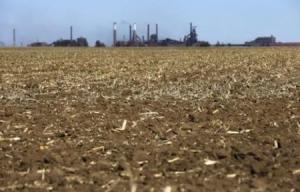Date: Fri, 2 Oct 2015 17:28:30 +0200
By Ed Stoddard
POTCHEFSTROOM, South Africa (Reuters) - Standing waist-deep in a hole, South African maize farmer Tom van Rooyen digs at the side with a small pickaxe.
"There is moisture 25 centimeters down but nothing beyond that. If we get below-average rains, it will be a disaster," he said, wiping the red dust from his calloused hands.
Poor rains are forecast for South Africa's maize belt because of the El Nino weather pattern, expected to bring more drought to already-parched southern regions in Africa and potential flooding in the east.
This will add misery to the world's poorest continent, already reeling from a collapse in commodity prices triggered by China's slowing economic growth.
Aid agency Oxfam warned this week that 10 million people, mostly in Africa, face hunger because of droughts and unusual rainfall patterns caused by a "super" El Nino.
Also called "Little Boy" or "Christ Child" - Peruvian fishermen first noted it around Christmas - El Nino is a warming of ocean surface temperatures in the eastern and central Pacific that occurs every few years. The last "super" El Nino occurred in 1997-1998.
While the weather phenomenon heralds drought in some parts of the globe and flooding in others, this one follows record temperatures linked to global warming.
DROUGHT FOLLOWED BY EL NINO
Drought cut the staple maize crop in South Africa, the region's biggest producer, by about a third this past season. It is likely to continue into the southern hemisphere summer as El Nino strengthens.
According to Thomson Reuters data, futures for the white maize contract used for human consumption - the staple of the poor - hit record highs over 3,000 rand ($215) a tonne in July and are within striking distance of that.
Inflation in Africa's most advanced economy moderated to 4.6 percent in August from 5 percent in July, but the central bank has warned that drought remains a concern because of its impact on food prices.
Drought has also hit South Africa's sugar crop, which the Cane Growers Association forecasts will fall to 14.9 million tonnes in the 2015-16 season from 17.7 million tonnes last year, which was already stunted, a fall of 15 percent.
South Africa is the world's second-largest citrus exporter, a 9 billion rand industry, and the northern Limpopo region which accounts for a third of the crop is under water restrictions, industry sources say.
HUNGER IN ZIMBABWE, FLOODS IN KENYA
Neighboring Zimbabwe has been hit hard by drought that has halved the maize harvest to 742,000 tonnes this year, according to the U.N.'s World Food Programme.
The government says drought is a major reason it cut the 2015 growth forecast to 1.5 percent from 3.2 percent. Aid agencies say 1.5 million Zimbabweans, or 16 percent of the population, would need food aid by next March.
The drought has also reduced power generation to 475 megawatts (MW) from 750 MW at the Kariba Hydro electricity plant, after water levels at the dam fell, forcing mines to reduce output in neighboring Zambia, Africa's second-biggest copper producer.
In west Africa, a lack of rainfall across Ghana's cocoa belt has raised fears that the world's No. 2 grower could be facing another poor crop.
In Ethiopia, 4.5 million people need food aid because of El Nino and long-term climate change, according to U.N. agencies.
However, the case in east Africa's biggest economy, Kenya, will be more mixed, according to Peter Ambenje, assistant director at its Meteorological Department. El Nino typically brings increased rains to Africa's east.
"Enhanced rainfall will boost farming even though farmers need to be aware of prevalence of diseases due to high moisture levels that may cause post-harvest losses," he told Reuters.
Recent El Nino events brought floods to Kenya in 1997-1998 and 2006-2007, resulting in losses of lives, harvests and livestock as well as infrastructure damage and outbreaks of hunger and disease.
Back in South Africa, Van Rooyen says he expects a tough year, but retains the stoic faith of a farmer.
"When they forecast a bad El Nino in the late 1990s, I still planted," he said, maneuvering his pick-up through the fields. "Then the rains came and I had a good crop that year."
($1 = 13.9120 rand)
(Additional reporting by MacDonald Dzirutwe in Harare and Edmund Blair in Nairobi; Editing by Dale Hudson)
